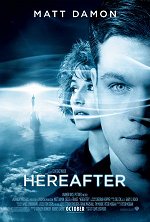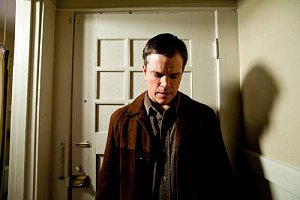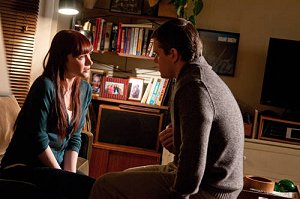 |
|
At The Picture Show
|
October 2010
Life support
Eastwood and Damon's earnest efforts can't breathe life into Peter Morgan's screenplay

Hereafter
Warner Bros. Pictures
Director: Clint Eastwood
Screenplay: Peter Morgan
Starring: Matt Damon, Cécile de France, Frankie McLaren, George McLaren, Jay Mohr, Bryce
Dallas Howard, Thierry Neuvic and Richard Kind
Rated PG-13 / 2 hours, 9 minutes
Opened October 22, 2010


 (out of four)
(out of four)
Peter Morgan screenplays epitomize why utter mediocrity is worse than just plain crap. Just
plain crap can be easily written off as exactly that. In fact, crap can be fascinating in its pure
crappiness, or in its ambitions or intentions or its unique failings.
But mediocrity. Oh, mediocrity is a sneaky little beast. It doesn't have the courage to fail. It
takes no chances; it offers nothing new; it just sits there, behaving nicely and accomplishing
nothing. And worst of all, it often presents the illusion of quality. (Or, to steal an old Pauline
Kael phrase, you could say it "reeks of quality.")
 This is the kind of mediocrity Morgan specializes in. His
scripts are exceedingly competent, structurally sound . . . and utterly devoid of interest. They hit
all the necessary dramatic cues that the story requires, but of course without bothering to make
any of the drama interesting. From The Queen to Frost/Nixon to Longford to The Other Boleyn
Girl and now Hereafter, this has been the case with Morgan. Stately scripts, stately films, that
nonetheless aren't nearly as fascinating as they should be. Their scripts lack any real drive - any
life. (Is it too much to ask for a little energy?)
This is the kind of mediocrity Morgan specializes in. His
scripts are exceedingly competent, structurally sound . . . and utterly devoid of interest. They hit
all the necessary dramatic cues that the story requires, but of course without bothering to make
any of the drama interesting. From The Queen to Frost/Nixon to Longford to The Other Boleyn
Girl and now Hereafter, this has been the case with Morgan. Stately scripts, stately films, that
nonetheless aren't nearly as fascinating as they should be. Their scripts lack any real drive - any
life. (Is it too much to ask for a little energy?)
To be fair, the success of any film goes far, far beyond the quality of its screenplay. But
nonetheless Morgan's work exemplifies the kind of competent yet sterile and unimaginative
films too often mistaken for something greater. They are, in a word, mechanical - they feel as
though they've been written by a computer program. If he were taking a college screenwriting
class on structure and formula, he would get an A. But structure and formula can't make up for
impersonal, shallow writing. No risk, no reward. On their own, his scripts provoke no visceral
reaction from me whatsoever - nor any intellectual curiosity. He's shallow across the board. To
put it another way, he writes TV movies that somehow manage to get mistaken for something
else.
Hereafter takes place in three countries, telling three stories that will inevitably connect at some
point. The first centers on a former professional psychic named George (Matt Damon), who has
shunned his "gift" because it prevents him from leading a normal life.
 The second focuses on a reporter, Marie LeLay (Cécile de
France), who has a profound near-death experience and tries to write about it, only to find
resistance from a scientific and literary community all too wary about broaching a subject as
sensitive as what happens after we die.
The second focuses on a reporter, Marie LeLay (Cécile de
France), who has a profound near-death experience and tries to write about it, only to find
resistance from a scientific and literary community all too wary about broaching a subject as
sensitive as what happens after we die.
The third story is about a 12-year-old British boy who loses his twin brother in a car accident
and tries to find a way to communicate with him beyond the grave.
All of that is potentially potent material - in some cases even controversial - but instead of an in-depth examination of any of it, we get a superficial once-over. At the admitted risk of harping
on a subject, nothing Morgan writes about seems to mean very much to him. Director Clint
Eastwood is more invested in the material in Hereafter, but only marginally. The most
intriguing of the three stories is that of Damon - not because of the psychic element (which is
treated with kid gloves) but because it's the only one of the three that seems like something of a
character study. The other two stories attempt the same thing, but get bogged down in the
mechanical hum of their (lifeless) narratives.
The story of the psychic, however, is less encumbered by story and a bit more interested in
George's internal crisis over what he should - or even can - do with his life. Worthy of
particular attention are the scenes between Damon and Bryce Dallas Howard, who plays a
woman George meets in a cooking class. The gentle way Eastwood and cinematographer Tom
Stern position the two characters as they build a rapport, and finally see their understanding of
one another change rapidly, makes powerful moments out of what otherwise may have felt
dramatically inert, or forced.
 It's unfortunate that, for one reason or another, the same kind of
care wasn't paid to the rest of the film. Why does Marie's supposedly life-changing experience
feel so rote, so prosaic? Why doesn't it feel like anything's actually at stake? And if this
character is delving deep into touchy subject matter, why doesn't the film have the courage to do
the same? Well, it's because Hereafter really isn't about any of the things it thinks it's about. All
of that is just window dressing. It's not that anything is especially bad about the movie - it's
fine. Just fine. And it's content being just fine. Inoffensive. Benign.
It's unfortunate that, for one reason or another, the same kind of
care wasn't paid to the rest of the film. Why does Marie's supposedly life-changing experience
feel so rote, so prosaic? Why doesn't it feel like anything's actually at stake? And if this
character is delving deep into touchy subject matter, why doesn't the film have the courage to do
the same? Well, it's because Hereafter really isn't about any of the things it thinks it's about. All
of that is just window dressing. It's not that anything is especially bad about the movie - it's
fine. Just fine. And it's content being just fine. Inoffensive. Benign.
Which is what makes it, upon reflection, somewhat maddening. After all, if a film doesn't even
have the conviction to follow through on its own material, what, in the end, does it matter?
What Hereafter was lacking wasn't an idea, or a story, or a cast, or a director - what it really
needed was some balls.
Continued Below Advertisement
Read more by Chris Bellamy